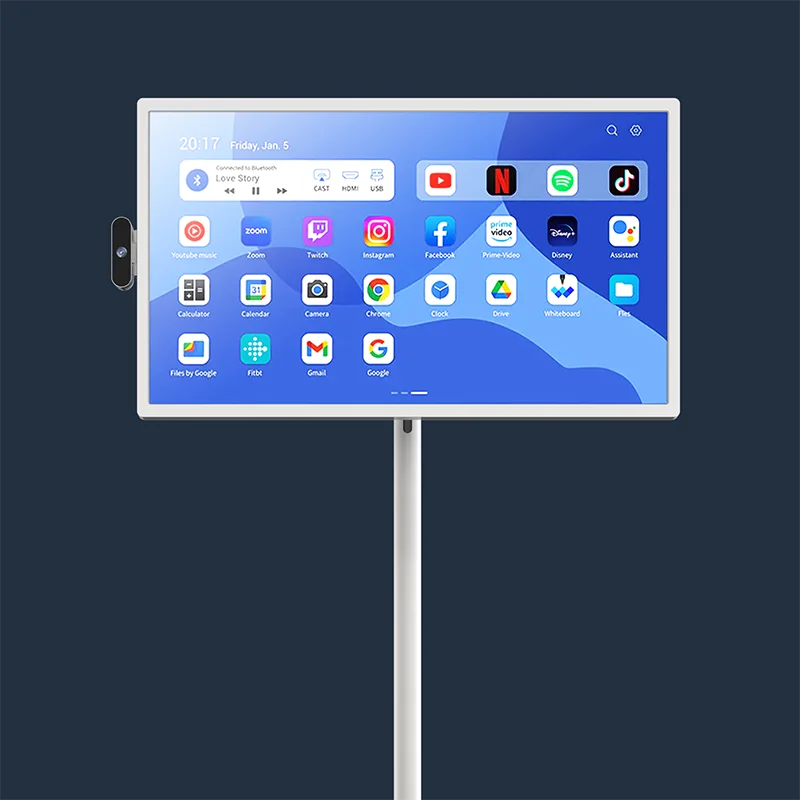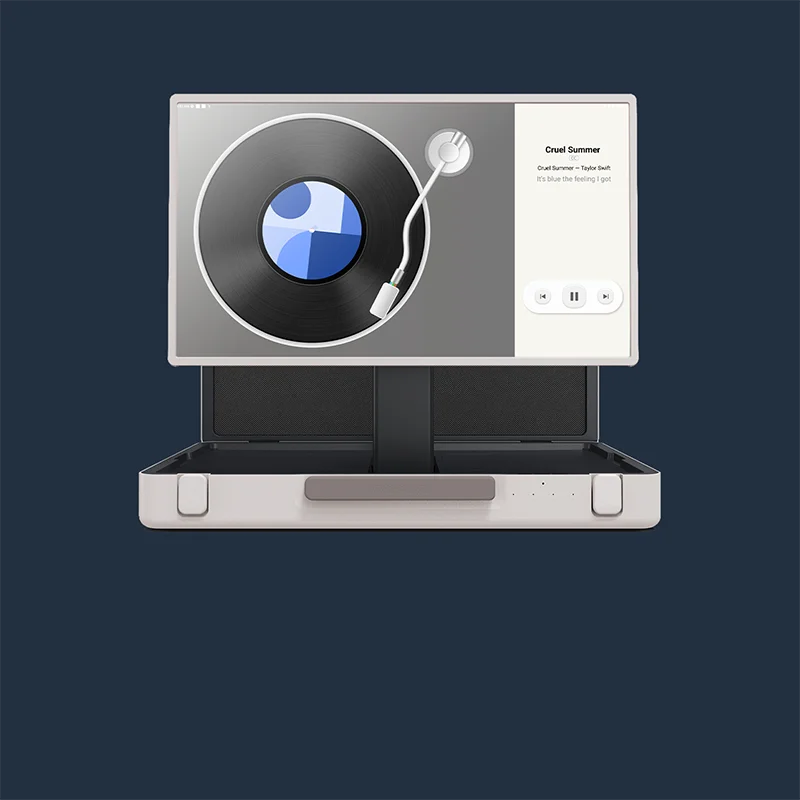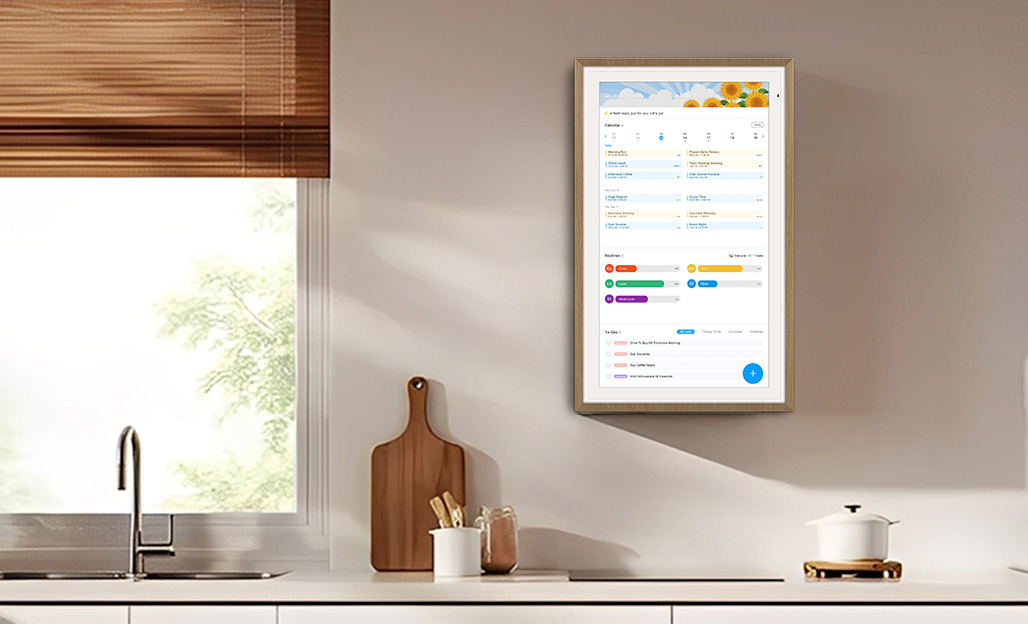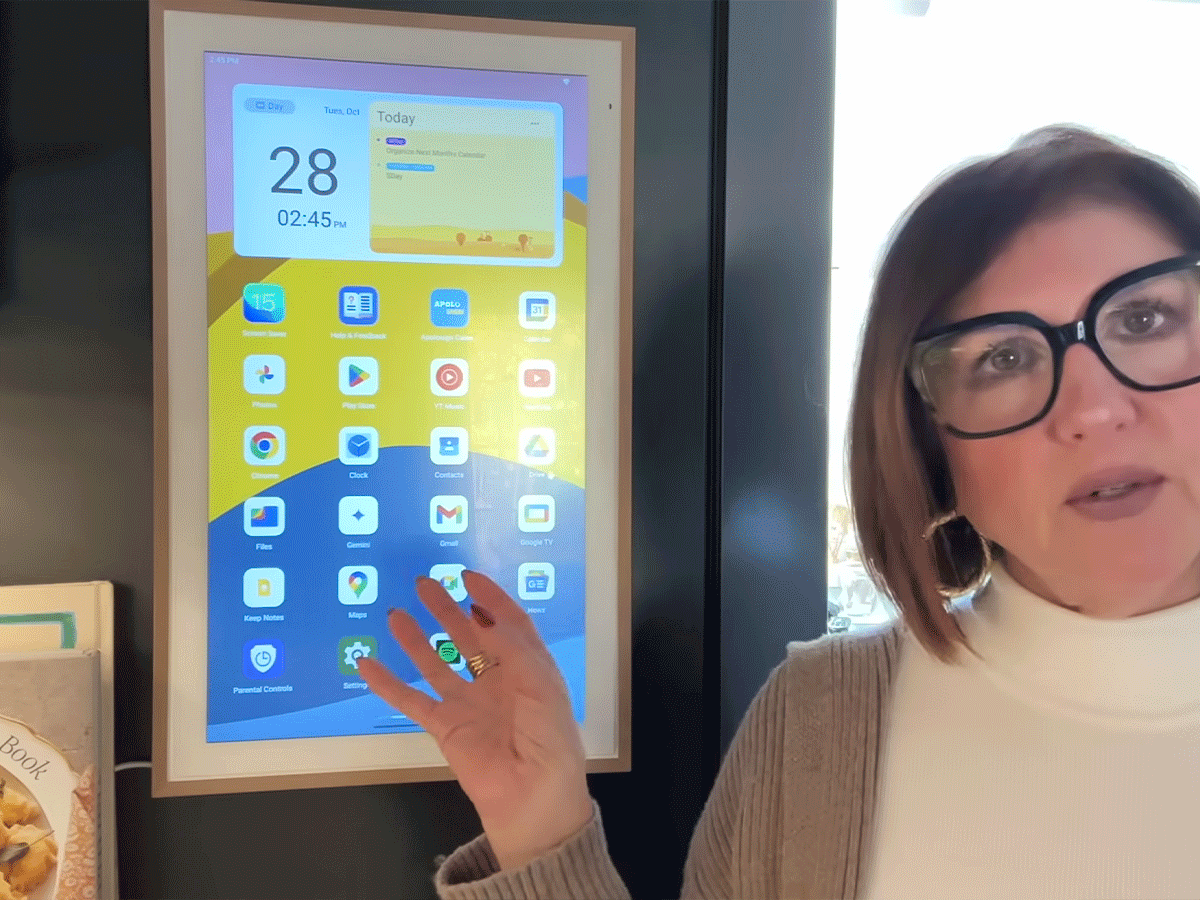The glow of a movie night no longer belongs to the living room. Imagine a screen that glides onto the patio, its picture sharp against the twilight sky. Picture a cooking show host life-sized in your kitchen, guiding you through a recipe without occupying an inch of counter space. A world of entertainment, untethered and unbound, is here.
Beyond the Living Room: Why Portable Smart TVs Are the Future of Entertainment
For years, we've been tethered to the wall. Our biggest and best screens were bolted down, demanding we come to them. But a quiet revolution has been brewing, a shift in how we live, work, and play. Our homes have become our offices, our backyards our cinemas, and our desire for flexibility has outgrown the static black rectangles in our living rooms. It's a trend reflected in our online habits; search interest for "mini tv" and "portable tv" sees consistent seasonal spikes, revealing a deep-seated consumer hunger for compact, mobile entertainment solutions.
What we're witnessing is the ultimate evolution of the "Lifestyle TV"—a category once defined as screens that could masquerade as art. Now, the concept has matured. A television should not just blend into a room's decor; it should adapt to your life's every scene. The technology has finally caught up to the dream. Powerful processors, long-lasting batteries, and brilliant, lightweight displays have converged to create an entirely new class of device. A portable smart tv isn't just a smaller screen; it's a declaration of freedom.

What Exactly is a Portable Smart TV?
So, what is one of these magical devices? Don't think of it as just a television. It's a brilliant hybrid, a fusion of a high-definition TV, an oversized tablet, and a mobile smart-home command center. It’s a jack-of-all-trades screen that follows you, ready to serve as a monitor for a work presentation one moment and a portal to Netflix the next. As the market blossoms, two distinct archetypes have emerged, each tailored to a different kind of freedom.
- The Home Roamer: Picture a sleek screen mounted on an elegant, wheeled stand. Its purpose is to liberate your content from a single room. It glides from the kitchen to the bedroom to the garage workshop with a gentle push. Models like the LG StanbyME and the Apolosign series champion this design, offering effortless mobility within your personal space.
- The Road Warrior: For those whose adventures extend beyond the front door, there's the Road Warrior. These devices pack the entire experience—screen, speakers, battery, and stand—into a rugged, self-contained briefcase. The LG StanbyME Go pioneered the concept of a screen in a "svelte suitcase," a design perfect for tailgates, campsites, and beach bonfires.
Understanding which archetype calls to you is the first step. Are you looking to enhance the flexibility inside your home, or are you looking to take a premium experience out into the world?
The Ultimate Checklist: 7 Key Features to Evaluate Before You Buy
Navigating a new tech category can feel like exploring a foreign land without a map. Let's chart the territory. Focus on these seven critical features, and you'll find the perfect travel companion for your digital life.
1. Screen & Picture Quality
Size, resolution, and brightness form the holy trinity of picture quality. For screen sizes under 32 inches, a Full HD 1080p resolution offers fantastic clarity. Some larger models, however, offer a 4K option for those who want the absolute sharpest image and a degree of future-proofing. But for a device meant to venture outside, the single most important specification is brightness, measured in nits. An average indoor TV has about 250-350 nits. A portable model with 300 nits, like the Apolosign 32" Smart Portable TV, is great for indoor use or a shaded patio in the evening. To compete with daylight, you need more firepower. A screen for a partially sunny spot needs at least 700 nits, while viewing in direct sun requires 1,000 nits or more.
2. Battery Life & Power
A portable TV without a good battery is just a small TV with an inconvenient cord. Manufacturers often advertise battery life of three to six hours. Treat these numbers as optimistic, best-case scenarios achieved under specific conditions. Real-world use, with higher brightness and Wi-Fi streaming, often yields less. A four-hour battery is good for a movie; a six-hour battery gives you a comfortable buffer for a sports doubleheader.
3. Portability & Design
How a device moves is as important as what it shows. For Home Roamers, look for a highly adjustable stand. The ability to change the height, tilt the screen up or down, and even rotate it 90 degrees into a vertical portrait mode is a game-changer for everything from browsing social media to coding. For Road Warriors, weight and a robust, integrated handle are paramount.
4. The "Smart" Operating System
The operating system (OS) is the brain of the device. It dictates what apps you can use and how smooth the experience feels. Many excellent portable tvs run on Android or the refined Google TV platform. An open ecosystem like Google's gives you access to the vast Google Play Store, so you can download virtually any streaming service or app you want. Proprietary systems, like LG's WebOS, are often slick but may have a more limited app selection. Also, look for integrated voice assistants like Google Assistant, which allow you to search for content or control playback with simple commands.
5. Connectivity
Ports matter. A standard HDMI input is non-negotiable; it's your gateway to connecting external devices like Blu-ray players or portable video game systems. For seamless streaming, modern Wi-Fi, such as Wi-Fi 6 (802.11ax), is a huge plus. And don't overlook Bluetooth. It's essential for connecting wireless headphones for private listening or, more importantly, pairing a better speaker.
6. Audio Quality
Let's be blunt: the built-in speakers on most portable devices are serviceable at best. Physics is a harsh mistress, and it's tough to get rich, deep sound from tiny speakers in a thin frame. While some models have decent audio, the best sonic experience will almost always come from pairing your portable TV with a quality portable Bluetooth speaker. Solid Bluetooth connectivity is your ticket to audio that matches the visual spectacle.
7. Durability & Weather Resistance
If your plans involve the great outdoors, durability is key. While most portable models are "outdoor-friendly," they are not a true outdoor tv. A dedicated outdoor tv is built to withstand rain, dust, and extreme temperatures, often carrying an official IP (Ingress Protection) rating. For most portable options, you'll want to avoid leaving them out in a downpour, but a rugged build quality offers peace of mind.

Finding Your Fit: Matching a Portable TV to Your Lifestyle
The best portable smart tv is the one that slots perfectly into your life. Let's look at a few common scenarios to see how different models fit.
The Urban Nomad
You live in a stylish apartment or a cozy home where space is a premium and every object needs to earn its keep. You need a screen that can be a sous-chef in the kitchen, a second monitor in your home office, and a private cinema in the bedroom. For you, agility is everything. The Apolosign 24" Smart Portable TV is your perfect match. Its compact 24-inch 1080p screen is crisp and clear without overwhelming a smaller room. With up to 4 hours of battery life and a nimble wheeled stand, it glides effortlessly between roles, acting as a TV, tablet, and monitor all in one.
The Family Entertainer
Your home is the hub of activity. You need a versatile screen that can keep the kids entertained in the playroom, host a video game tournament, or roll out to the deck for a family movie night under the stars. You need a bigger screen and more stamina. Look no further than the Apolosign 32" Smart Portable TV. Its larger 32-inch display, available in either 1080p or a stunning 4K resolution, creates a more immersive experience for everyone. Its beefy battery runs for up to 6 hours, enough for the longest animated feature or championship game. It even features a smart home dashboard to help manage a busy family's schedule.
The Road Warrior
Your idea of a good time involves a campfire, a tailgate, or the open road. You need a device built for adventure, one that's tough, self-contained, and ready to go at a moment's notice. The Apolosign PackGo 27" Briefcase Portable TV is engineered for this life. Its all-in-one briefcase design protects the 27-inch screen during transit, popping open to become an instant entertainment center. It’s the ultimate portable tv for camping and the perfect upgrade for any tv for travel trailer, delivering high-quality entertainment far from the nearest wall outlet.
Smart Buyer's Tips: How to Make a Confident Choice
You're armed with the knowledge. Now, here are a few final tips to guide you to a confident purchase.
- Prioritize Your Primary Use Case. Be honest with yourself. If the TV will spend 90% of its life indoors, don't overpay for rugged features you'll never use. If you dream of sunny afternoon viewing, screen brightness (nits) is the only number that truly matters.
- Look Beyond the Spec Sheet. A spec sheet tells you what a device can do, not how well it does it. Scour reviews from real-world users. They'll give you the unvarnished truth about actual battery life, screen visibility in different lighting, and the quirks of the software.
- Test Drive the OS. If you can, find a model in a store and play with the user interface. A device that relies on touch and fluid navigation can be ruined by a clunky, unresponsive OS.
- Don't Forget the Ecosystem. If your digital life revolves around Apple products, confirm that the TV has robust AirPlay support for easy screen mirroring. Android and Windows users will feel right at home with a Google TV-based system.
- Consider the Alternative (and Why It Falls Short). Could you just pair a portable monitor with a streaming stick and a power bank? Yes. But you'd be juggling three devices and a nest of cables. The magic of a dedicated portable smart tv is its seamless, all-in-one, battery-powered integration. It's an appliance, not a project.
Your Entertainment, Unplugged and Unrestricted
The portable smart tv represents more than just a new gadget. It’s a fundamental shift in our relationship with media. Entertainment is no longer a destination, a room you must go to. It is now a companion, as mobile, spontaneous, and flexible as you are. The screen is finally free from the wall, and so are you. As technology marches on, expect to see even brighter screens, batteries that last all day, and smarter AI that anticipates what you want to watch next. The future of entertainment isn't just on-demand; it's on-the-go.
One final question: Where will you watch? For moving around the house, a wheeled stand model like the Apolosign 24" or 32" offers incredible flexibility. For true adventure, a briefcase model like the Apolosign PackGo 27" is your ticket to entertainment anywhere. Pay closest attention to battery life and screen brightness (nits)—these specs will define your experience more than anything else.

FAQs
Q1: Can I use a portable smart tv on stand as a primary monitor for my work-from-home setup?
A: Absolutely. Most models feature HDMI ports for a simple, universal connection to your laptop. The ability to rotate the screen to a vertical orientation, a feature on many wheeled models, is a fantastic bonus for coding, reading long documents, or managing social media feeds. Just check that the resolution meets your needs for text sharpness.
Q2: How does a portable digital television get channels when I'm camping with no Wi-Fi?
A: A portable digital television that includes a built-in ATSC tuner and a coaxial input can connect to a simple portable TV antenna. With an antenna, you can receive free, over-the-air broadcast channels (like ABC, NBC, CBS, and Fox) wherever you can get a signal. It's a fantastic, internet-free backup for news and entertainment.
Q3: Are these portable tvs bright enough to be considered a true outdoor tv for my sunny patio?
A: Generally, no. Most current portable models offer 250-400 nits of brightness, which is excellent for shaded patios, covered decks, or evening viewing. However, dedicated outdoor tv units designed for partial or full sun start at 700 nits and can go well over 2,000 nits to combat direct sunlight. Think of a portable model as "outdoor-friendly," not a dedicated, sun-proof screen.
Q4: I have a tv for travel trailer that runs on 12V power. Can these new smart TVs work with that?
A: It depends on the model's power system. Most portable smart TVs are designed to be charged with their own 110V AC power adapters. To use one with a native 12V DC system in a tv for travel trailer, you would typically need a power inverter, which converts your trailer's 12V DC power to the 110V AC the TV's charger requires.
Q5: My kids want to hook up their portable video game systems. Is there any lag?
A: For the vast majority of gaming, the experience is excellent. These TVs typically have a standard 60Hz refresh rate, which is a perfect match for consoles like the Nintendo Switch, PlayStation 4, or Xbox One. Connecting is simple via the built-in HDMI port. While elite, competitive gamers playing high-framerate PC games might prefer a specialized 120Hz gaming monitor, these screens are more than capable of delivering a fun, responsive experience for casual and console gaming on the go.










